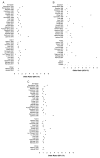Angiotensin II type 1 receptor polymorphisms and susceptibility to hypertension: a HuGE review
- PMID: 18641512
- PMCID: PMC4993203
- DOI: 10.1097/gim.0b013e3181809613
Angiotensin II type 1 receptor polymorphisms and susceptibility to hypertension: a HuGE review
Abstract
The angiotensin II type 1 receptor (AGTR1) plays an integral role in blood pressure control, and is implicated in the pathogenesis of hypertension. Polymorphisms within this gene have been extensively studied in association with hypertension; however, findings are conflicting. To clarify these data, we conducted a systematic review of association studies of AGTR1 polymorphisms and hypertension, and performed a meta-analysis of the rs5186 variant. Results show that the currently available literature is too heterogeneous to draw meaningful conclusions. The definition of hypertension and gender composition of individual studies helps to explain this heterogeneity. Although the structure and splicing pattern of AGTR1 would suggest a likely effect of polymorphisms within the promoter region on gene function, few studies have been conducted thus far. In conclusion, there is insufficient evidence that polymorphisms in the AGTR1 gene are risk factors for hypertension. However, most studies are inadequately powered, and larger well-designed studies of haplotypes are warranted.
Figures

References
-
- Laragh J, Pickering TG. Essential hypertension. In: Brenner B, editor. Brenner & Rector’s the kidney. Philadelphia: W.B. Saunders Company; 1991. pp. 1913–1967.
-
- Gasparo M, Bullock G. The AT1 and AT2 angiotensin receptors. In: Oparil S, Webber M, editors. Hypertension: a companion to Brenner & Rector’s the kidney. Philadelphia: W.B. Saunders Company; 2000. pp. 101–110.
-
- Brenner B, Cooper M, de Zeeuw D, et al. Effects of losartan on renal and cardiovascular outcomes in patients with type 2 diabetes and nephropathy. N Engl J Med. 2001;345:861–869. - PubMed
-
- Lewis EJ, Hunsicker LG, Clarke WR, et al. Renoprotective effect of the angiotensin receptor antagonist irbesartan in patients with nephropathy due to type 2 diabetes. N Engl J Med. 2001;345:851–860. - PubMed
-
- Guo D, Furuta H, Mizukoshi M, Inagami T. The genomic organization of human angiotensin II type 1 receptor. Biochem Biophys Res Commun. 1994;200:313–319. - PubMed
Publication types
MeSH terms
Substances
Grants and funding
LinkOut - more resources
Full Text Sources
Medical
